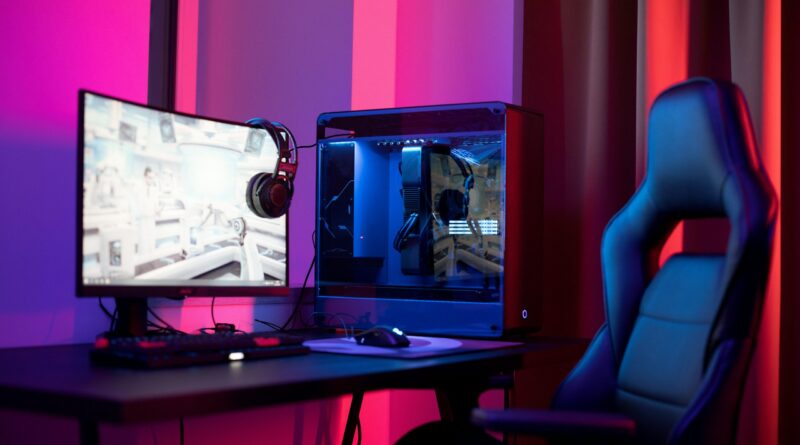Creating a perfect gaming room is something many gamers dream about. A well-designed gaming space can enhance your gaming experience, improve comfort during long sessions, and showcase your personality. I’ve researched extensively and gathered four essential tips that will help you transform any space into an ideal gaming sanctuary. Whether you’re working with a dedicated room or just a corner of your bedroom, these suggestions will take your gaming setup to the next level.
Spis treści:
1. Optimize Your Space Layout
The foundation of any great gaming room starts with thoughtful space planning. Before purchasing equipment or furniture, I recommend measuring your available area and sketching a rough layout. Consider the natural light sources in the room and position your setup to minimize screen glare. If possible, place your gaming station away from windows or invest in blackout curtains.
Cable management is another vital aspect of space optimization. Nothing ruins a clean gaming setup faster than a tangled mess of wires. Use cable sleeves, clips, or raceways to keep everything organized. Consider drilling small holes in your desk for cables to pass through or mount a power strip underneath your desk to minimize visible cords.
Don’t forget about traffic flow in your gaming room. Leave enough space between furniture pieces to move comfortably, especially if you plan to use VR equipment that requires room-scale movement. Remember that a cluttered space leads to a cluttered mind, which isn’t ideal for gaming focus.
2. Choose the Right Furniture and Equipment
Selecting appropriate furniture makes a significant difference in gaming comfort and performance. Start with a supportive gaming chair that promotes good posture during long sessions. Look for features like adjustable armrests, recline capabilities, and lumbar support. Your health shouldn’t be compromised for the sake of gaming!
Your desk choice is equally important. I suggest a desk with ample surface area for your monitor(s), keyboard, mouse, and other peripherals. Height-adjustable desks are excellent options as they allow you to alternate between sitting and standing, reducing the physical strain of extended gaming sessions.
When it comes to equipment, prioritize items that match your specific gaming needs. For PC gamers, invest in a quality monitor with appropriate refresh rates and response times. Console gamers should consider optimal TV placement and viewing distance. Don’t forget about audio – a good headset or speaker system can dramatically enhance immersion. Remember that quality often trumps quantity – it’s better to have fewer high-quality pieces than numerous mediocre ones.
3. Create Perfect Lighting Conditions
Lighting plays a crucial role in both the functionality and atmosphere of your gaming room. Poor lighting can cause eye strain and headaches, while well-planned lighting enhances the gaming experience and creates ambiance.
Task lighting is essential for illuminating your immediate gaming area without causing screen glare. Consider a desk lamp with adjustable brightness or LED light strips mounted behind your monitor for bias lighting, which reduces eye strain during low-light gaming sessions.
Ambient lighting sets the mood for your gaming space. RGB LED strips have become popular choices as they can change colors to match your game’s atmosphere or your personal preferences. Smart lighting systems allow you to control brightness and color from your phone or through voice commands, letting you adjust the atmosphere without interrupting your gameplay.
Remember to balance aesthetic lighting with functionality. While a room bathed in red light might look cool for gaming sessions, you’ll want the ability to switch to normal lighting when using the space for other activities. Consider installing dimmer switches or using smart bulbs that can transition between practical and atmospheric lighting with ease.
4. Add Personal Touches and Accessories
The final touch to any gaming room is personalizing it to reflect your gaming passion and style. Display your favorite game collectibles, posters, or artwork to make the space uniquely yours. Floating shelves work well for showcasing figurines or limited edition game packages without taking up floor space.
Consider sound management, especially if you share your living space with others. Acoustic panels can reduce echo and improve sound quality while also serving as decorative elements. Thick curtains and rugs help absorb sound and prevent it from traveling to other rooms.
Storage solutions are often overlooked but necessary for keeping your gaming room organized. Dedicated storage for games, controllers, and accessories helps maintain a clean space and protects your investment. Consider drawer units, wall-mounted controller holders, or specialized gaming storage furniture.
Don’t forget about comfort accessories like a small refrigerator for drinks, a comfortable throw blanket for cooler gaming sessions, or even plants to improve air quality. These small additions make long gaming sessions more enjoyable and reduce the need to interrupt your gameplay for basic comforts.
Remember that your gaming room should evolve with your needs and preferences. Start with these fundamental tips and adjust as you discover what works best for your unique gaming style and space constraints. Happy gaming!
